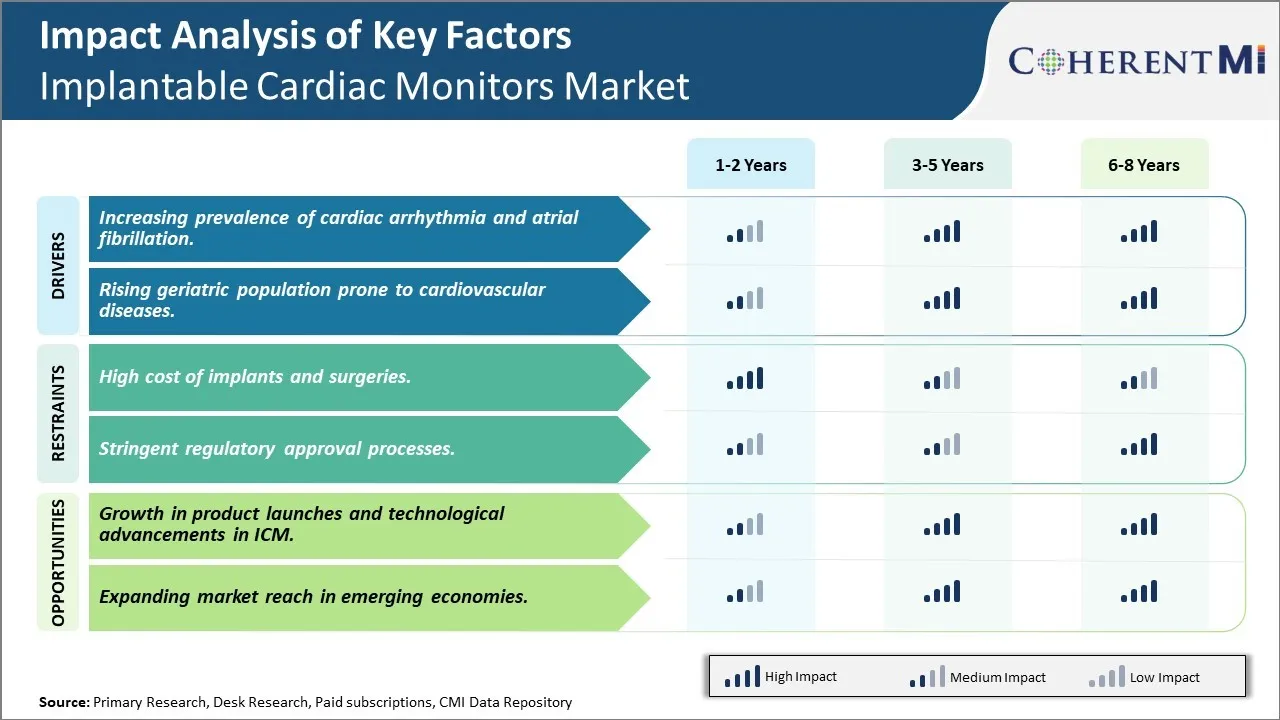Implantable Cardiac Monitors Market Trends
Market Driver - Increasing prevalence of cardiac arrhythmia and atrial fibrillation
The global prevalence of cardiac arrhythmias and atrial fibrillation has been consistently rising over the past few decades. These conditions occur when the electrical signals that coordinate the heartbeat get disrupted, causing the heart to beat too fast, too slow or irregularly. Some of the key factors responsible for the increasing incidence include aging population, unhealthy lifestyle behaviors such as smoking, excessive alcohol consumption and obesity, rising rates of other chronic diseases like hypertension and diabetes as well as advancements in diagnostic capabilities.
Today, atrial fibrillation alone impacts over 30 million people worldwide and is a significant contributor to stroke, heart failure and other cardiac complications. It is more common in developed nations due to longer life expectancy and high burden of cardiovascular risk factors. As per estimates, close to 12 million Americans are likely to have atrial fibrillation by 2030. Even though most cardiac arrhythmias are generally well-tolerated, some can be life-threatening depending on the severity. In order to effectively manage these conditions and prevent adverse outcomes, it is important to closely monitor the heart rhythm.
Implantable cardiac monitors have emerged as an important diagnostic tool for long term heart monitoring in patients with suspected arrhythmia or fainting episodes. They can detect and record arrhythmias continuously for extended periods compared to conventional external holter or event monitors. This helps physicians get a better clarity on often intermittent arrhythmias and determine appropriate treatment approach. Growing awareness about benefits of early detection and management of cardiac rhythm disorders is driving higher demand for long term continuous cardiac monitoring devices like implantable cardiac monitors. With aging population demographic and increasing risk factor prevalence, cases of arrhythmia and atrial fibrillation requiring monitoring are projected to rise tremendously in the coming years.
Market Driver - Rising geriatric population prone to cardiovascular diseases
Advanced age is one of the major non-modifiable risk factors for development of cardiovascular diseases. Physiological changes associated with aging like stiffening of arteries, reduction in heart muscle mass, and alterations in cardiovascular regulation make the cardiovascular system weaker and more susceptible to diseases over time. Currently, people aged 65 years and above make up around 8-10% of the total population in developed countries. However, this demographic is growing rapidly and is projected to double by 2050 according to estimates from United Nations.
Developing nations are also experiencing consistent rise in geriatric population share due to expanding life expectancy and decreasing birth rates. Aged segment of the population faces higher burden of medical illnesses commonly associated with aging like hypertension, diabetes, COPD as well as cardiac arrhythmias. Studies show aged adults have two to three times greater likelihood of atrial fibrillation compared to younger population. Even minor cardiac arrhythmias that may not appear problematic in youth can pose higher risks in elderly due to frailty and other comorbidities prevalent at advanced age. Therefore, continuous monitoring of heart rhythm assumes greater importance in geriatric patients.
Implantable cardiac monitors have found widespread adoption for long term cardiac monitoring in aged population. Their ability to continuously track heart rhythm over longer periods without interfering in daily activities of users has significant advantages for the senior patients. Early detection of arrhythmias through these devices helps guide timely clinical interventions and optimize medical management in order to prevent adverse consequences. With steady rise in global geriatric demographic expected in the coming decades, the requirement for cardiac monitoring solutions like implantable monitors specifically tailored to the aged population is likely to rise at an accelerated pace.

Market Challenge - High cost of implants and surgeries
The high cost of implantable cardiac monitors and the surgeries associated with their implantation poses a significant challenge for the growth of the implantable cardiac monitors market. Implantable cardiac monitors are expensive medical devices with the cost of an individual device ranging from $5000 to $10000. Additionally, the surgical procedures required for implantation of these devices are also costly procedures typically performed in hospitals or ambulatory surgical centers. The implantation of an ICM usually requires a minor operation under local anesthesia and could cost between $10000 to $20000 when the costs of the surgical facility, anesthesia and surgery are all added. For many patients and healthcare systems, these high procedure costs serve as barriers to the adoption and widespread use of implantable cardiac monitors. With healthcare budgets under increasing pressure globally, providing insurance coverage or reimbursements for such expensive cardiac procedures poses difficulties. This high total cost of care could limit the full market potential of implantable cardiac monitors.
Market Opportunity - Growth in product launches and technological advancements in ICM
The implantable cardiac monitors market has strong growth opportunities driven by ongoing product launches and technological advancements in these medical devices. Over the last few years, there has been significant innovation with manufacturers introducing new ICM products with enhanced features and functionalities. Many new devices now have more memory to store cardiac information, improved wireless data transmission capabilities and smaller sizes for easier implantation. Some products also integrate artificial intelligence-based algorithms to better analyze cardiac arrhythmia. Such innovations are helping Implantable cardiac monitors gain popularity among physicians and patients as viable diagnostic tools. Furthermore, as leading medical device companies continue investing in R&D, more advanced ICMs with features like remote patient monitoring and integrated cardiac therapy delivery are expected to be launched in the coming years. These ongoing product improvements and new offerings will attract more users and aid the implantable cardiac monitors market in expanding over the long-term.